![]() Shin-Izu
Shin-Izu
This layout has been built by Anthony Mc Diarmid, owner of JR Model Supplies, a specialist modelshop in England.
The layout has been shown at several exhibitions in England and once in Dortmund, Germany. Now it has found a more permanent home in Mr. Mc Diarmid's shop.
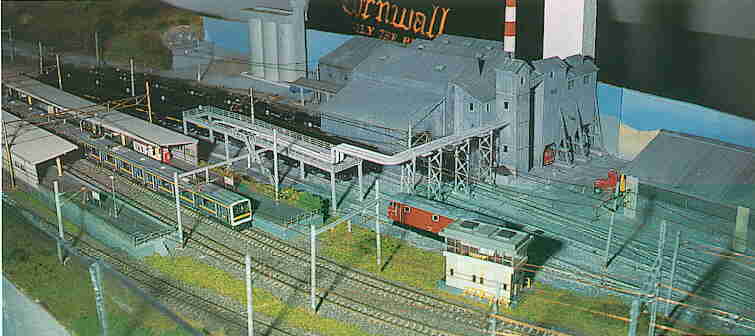
The cement works and Minami-Ito station on 'Shin-Izu'
The layout depicts a fictuous joint JR and Izu Kyuko Dentetsu line at the Izu peninsula, some 100 km southwest of Tokyo. In reality such an operation exists, but the track layout on the models has come from the brain of the modeller. The layout is built in Japanese N-scale, which is 1:150 and not 1:160 as usual on the European Continent and in the USA. The track gauge is still 9mm, so normal N-scale track can be used. In real life trains on these routes run on a track gauge of 3'6" or 1067mm if that's easier for you. The Japanese model railway manufacturers didn't bother to convert this narrower than standard gauge into a special model railway narrow gauge, so 9 mm is used. Purists can use a gauge of 7mm, but need to narrow the wheelsests of all their models and construct their own track.
The layout is some 17 x 8 foot large, the baseboards are set up in an 'U' shape, between the legs of the 'U' there is space for the layout operators, normally four; the layout can be run by a minimum of two and a maximum of five operators (Well that's fun, standing with five in a restricted space and run the trains to the timetable). I had the chance to be one of the operating team at the Intermodellbau show in Dortmund, Germany in April 1997. I never had operated a layout like this one but catched up really quickly, and had a great time running the trains and had lots of fun with the other operators, one of which was a female :-).
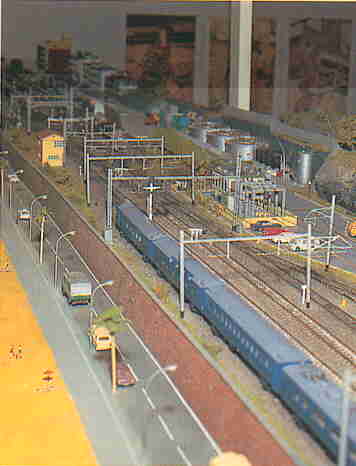
A look towards 'Shin Izu' station. The blue train is a Japanese night train.
Home built items on 'Shin-Izu'.
A few things on 'Shin-Izu' are home built. Most things homebuilt items could be built by more or less experienced modellers.
Firstly, the catenary supports are home made from brass tube and other shapes loke 'L's and channels. These are cut to lenght and assembled on a jig. The overhead wires are normal Sommerfeldt, known as the catenary specialists. Secondly, the signals are either 'Berko' or 'Eckon' British outline or home made Japanese outline and thus more prototypical than the British ones. Japanese signals are mostly colour-light and have a striking similarity with American 3-light and Dutch 3-light signals.
The catenary supports and signals are available as ready-made products at Mr. Mc. Diarmids model shop (See 'Railway Modeller', 'Continental Modeller' and 'Model Rail' for the adress. I have no business relationship with Mr. Mc. Diarmid and by these pages he gets enough free advertising :-).
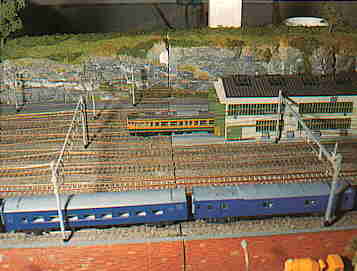
The depot with an EMU emerging from the carriage shed.
The trackplan is a classical British 'terminus-to-fiddle yard' with an extra intermediate station (Minami-Ito, see above). The terminus (Shin-Izu) is built along the seaside, there is a sandy beach and a small fishing port. The station itself has four platform roads and two platforms. Further facilities include a freight yard, oil storage tanks, an EMU / carriage depot and a small loco depot. As this layout is modern image, there are no facilities to service steam locos, there is only a fueling point for diesel locos.
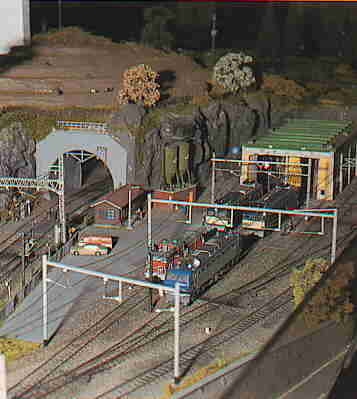
A view at the loco depot.
On the 'bottom-leg' of the 'U' there is a scenic section with mountains and a river and waterfall. The up and down lines of the railway seperate here; this is very usual in Japan as many railways have been built as single track lines in awkward locations. When the lines were doubled, the second track was to be laid up to several hundreds of metres away. A good example is the now closed 'Shin-Etsu' mountain line between Yokogawa and Karuizawa, part of the route between Tokyo and Nagano. This spectacular mountain railway is now replaced by the Nagano Shinkansen route.
On the right leg of the 'U' there is a small station with two side platforms and a large cement works. The cement works needs limestone supplies and needs transportation for the cement. This is all done by rail and there are many sidings serving this industry. In a corner is a small goods shed. Then the main lines enter a tunnel which ends at the fiddle yard (or hidden sidings). At this yard there is space for 10 full-length trains, up to 8 carriages and locomotive long.
On the technical side this layout is not very remarkable. Nearly all track is Peco, either standard code 80 or finescale code 55 flexible track. Most points are Peco code 55, but a few are handmade. Control of the trains is by means of handheld Gaugemaster 'W' walkaround controllers, without any features as 'brake' or 'momentum'. Each station has its own control panel on which cheap toggle switches are mounted. The points are activated by Lemaco slow action point-motors. These things are reliable but noisy. Throwing a point makes an awesome 'growl'.
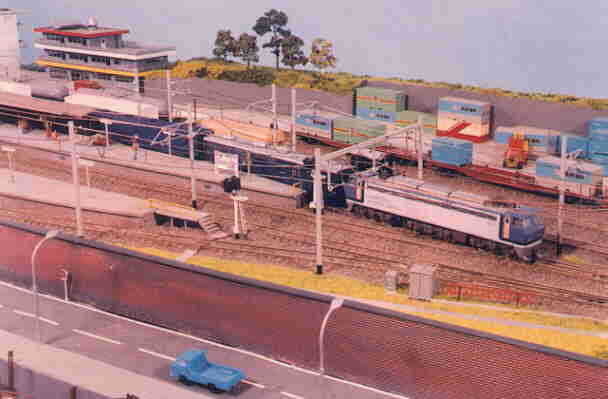
A mail train at 'Shin-Izu'
Unfortunately this fine layout can only be seen at Mr. Mc. Diarmids model shop, which is located in a remote part of England. Due to his policy towards exhibition managers Mr. Mc. Diarmid is not too often invited to model railway shows.
 Modelling
Modelling  Layouts
Layouts  Modeller's
Corner
Modeller's
Corner  Train
Simulators
Train
Simulators  Various
Various